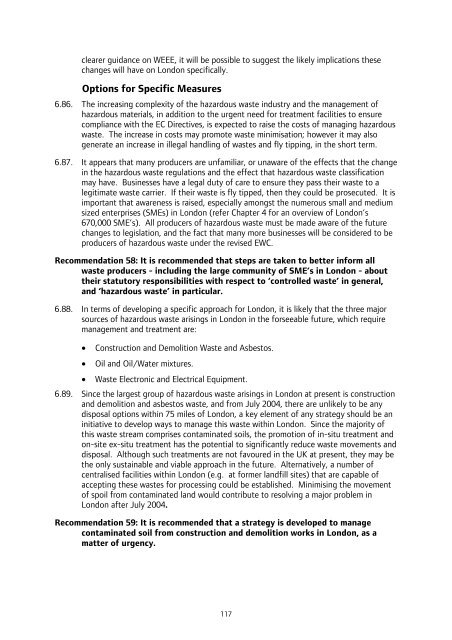London Wider Waste Strategy - London - Greater London Authority
London Wider Waste Strategy - London - Greater London Authority
London Wider Waste Strategy - London - Greater London Authority
Create successful ePaper yourself
Turn your PDF publications into a flip-book with our unique Google optimized e-Paper software.
clearer guidance on WEEE, it will be possible to suggest the likely implications these<br />
changes will have on <strong>London</strong> specifically.<br />
Options for Specific Measures<br />
6.86. The increasing complexity of the hazardous waste industry and the management of<br />
hazardous materials, in addition to the urgent need for treatment facilities to ensure<br />
compliance with the EC Directives, is expected to raise the costs of managing hazardous<br />
waste. The increase in costs may promote waste minimisation; however it may also<br />
generate an increase in illegal handling of wastes and fly tipping, in the short term.<br />
6.87. It appears that many producers are unfamiliar, or unaware of the effects that the change<br />
in the hazardous waste regulations and the effect that hazardous waste classification<br />
may have. Businesses have a legal duty of care to ensure they pass their waste to a<br />
legitimate waste carrier. If their waste is fly tipped, then they could be prosecuted. It is<br />
important that awareness is raised, especially amongst the numerous small and medium<br />
sized enterprises (SMEs) in <strong>London</strong> (refer Chapter 4 for an overview of <strong>London</strong>’s<br />
670,000 SME’s). All producers of hazardous waste must be made aware of the future<br />
changes to legislation, and the fact that many more businesses will be considered to be<br />
producers of hazardous waste under the revised EWC.<br />
Recommendation 58: It is recommended that steps are taken to better inform all<br />
waste producers - including the large community of SME’s in <strong>London</strong> - about<br />
their statutory responsibilities with respect to ‘controlled waste’ in general,<br />
and ‘hazardous waste’ in particular.<br />
6.88. In terms of developing a specific approach for <strong>London</strong>, it is likely that the three major<br />
sources of hazardous waste arisings in <strong>London</strong> in the forseeable future, which require<br />
management and treatment are:<br />
• Construction and Demolition <strong>Waste</strong> and Asbestos.<br />
• Oil and Oil/Water mixtures.<br />
• <strong>Waste</strong> Electronic and Electrical Equipment.<br />
6.89. Since the largest group of hazardous waste arisings in <strong>London</strong> at present is construction<br />
and demolition and asbestos waste, and from July 2004, there are unlikely to be any<br />
disposal options within 75 miles of <strong>London</strong>, a key element of any strategy should be an<br />
initiative to develop ways to manage this waste within <strong>London</strong>. Since the majority of<br />
this waste stream comprises contaminated soils, the promotion of in-situ treatment and<br />
on-site ex-situ treatment has the potential to significantly reduce waste movements and<br />
disposal. Although such treatments are not favoured in the UK at present, they may be<br />
the only sustainable and viable approach in the future. Alternatively, a number of<br />
centralised facilities within <strong>London</strong> (e.g. at former landfill sites) that are capable of<br />
accepting these wastes for processing could be established. Minimising the movement<br />
of spoil from contaminated land would contribute to resolving a major problem in<br />
<strong>London</strong> after July 2004.<br />
Recommendation 59: It is recommended that a strategy is developed to manage<br />
contaminated soil from construction and demolition works in <strong>London</strong>, as a<br />
matter of urgency.<br />
117
















